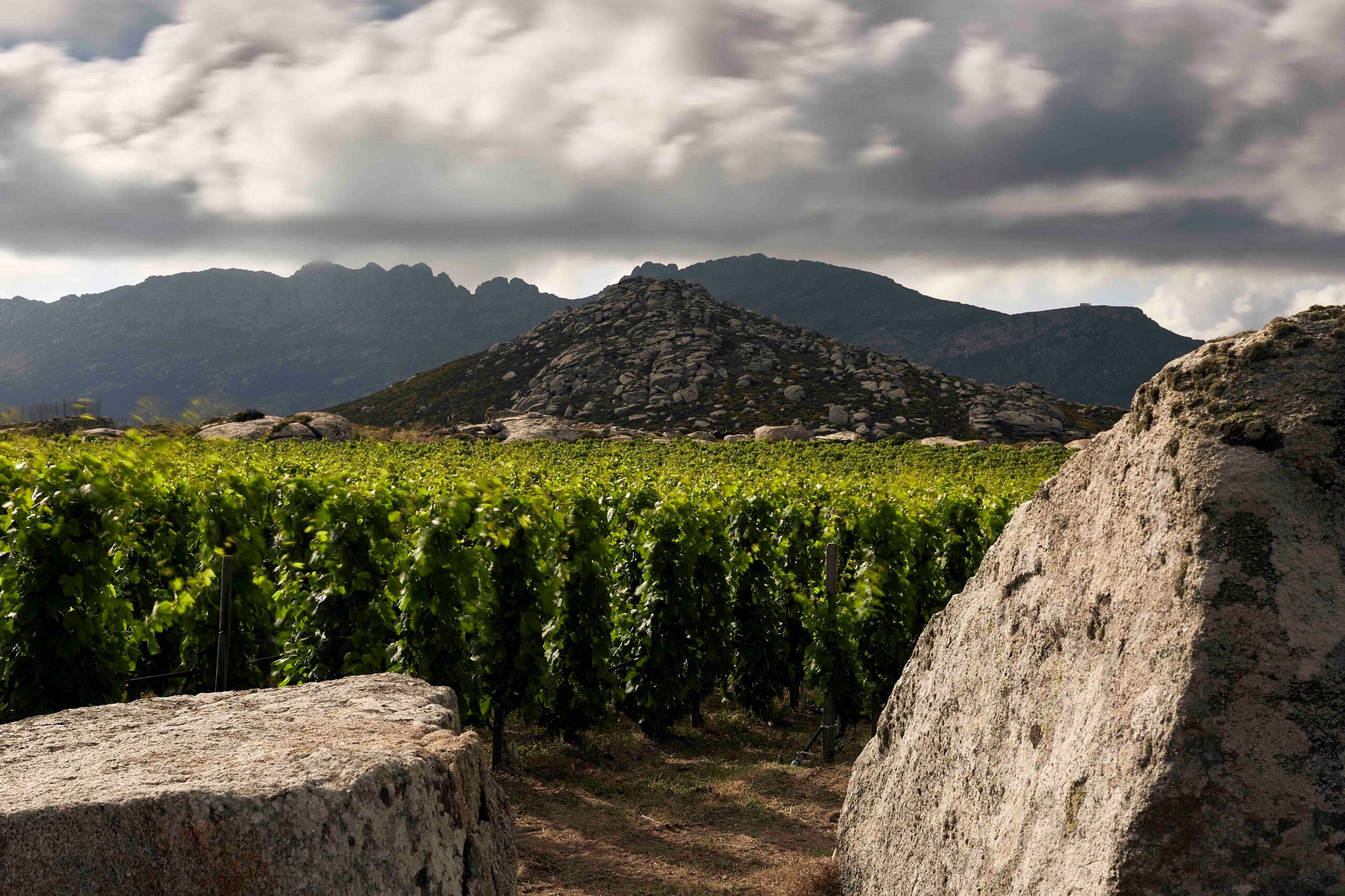When we rented a car on Tinos, before a spot of sightseeing, the assistant gave us a demonstration of how to open and close a car door without it getting caught by the wind. This involved using your body weight and wedging your leg inside before clambering in.

Not only does this prevent you damaging other cars and trapping appendages but, if you don’t exercise caution, the wind is so powerful here that it can rip a car door off its hinges. Literally.
When we were told, before our visit to the T-Oinos winery on Tinos that this island in the centre of the Cyclades was “windy” nothing could have prepared us for just how windy. For an entire week the Etesian wind was an unrelenting 50-60km, almost blowing us off our feet, moaning day and night through every tiny gap in every crevice of the hotel, that somehow managed to stay connected to its foundations. There was a reason the hotel doors were automatic.
And this was at sea level. Head up 470m to the Stegasta Plateau where T-Oinos has its iconic vineyard amongst wind-rounded, giant boulders of pink granite and the elements become a thing of the Gods.
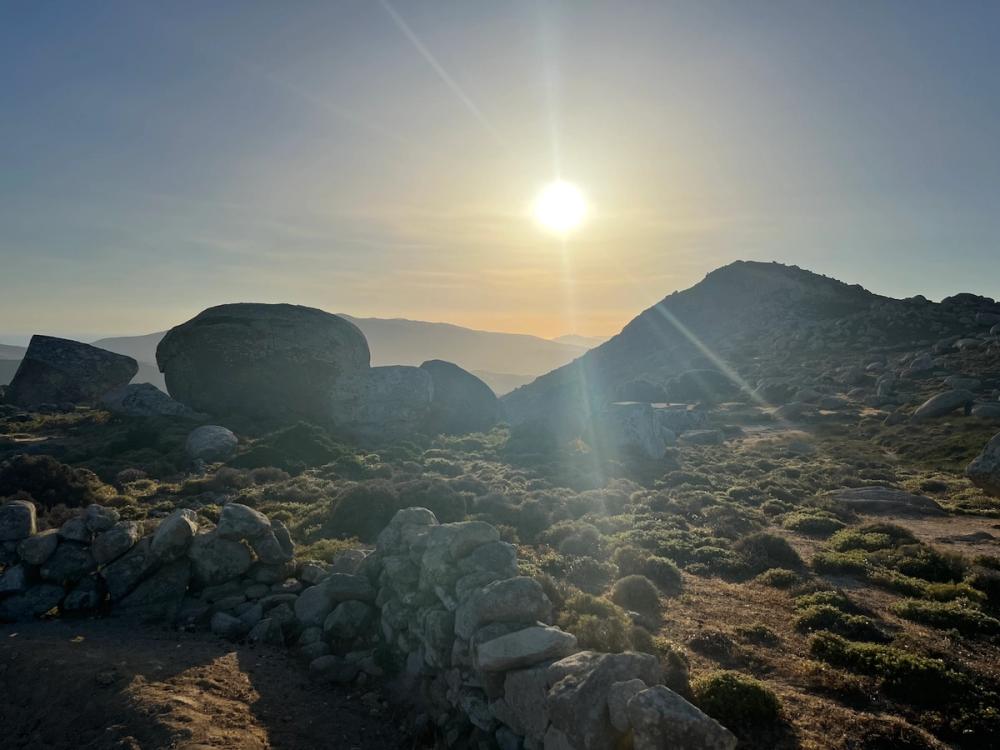
Stegasta Plateau - like stepping into another world
The plateau is a surreal lunar landscape that looks like it has been pelted with boulders. There’s also a palpable energy here that seems to be wired into a primordial current, the kind of force that created this astonishing landscape in the first place.
When I asked winemaker Thanos Georgilas why he chose to move from his previous job at Château Latour to be winemaker at T-Oinos he replied in a heartbeat: “When I saw the vineyard. When I first saw it I said ‘I want in’.”
Clos Stegasta is not a World Heritage Site by accident, it’s because it’s one of the most unique places on earth – with or without vines.
And here’s the thing – vines love this place. Shallow sandy soil over granite bedrock, vines planted North-South so the wind provides natural air conditioning, yields kept in check through a planting density of 10,000 vines per hectare … and all day there’s a constant, fine film of fog that is swept across the azure-blue sky, protecting the berries from sunburn.
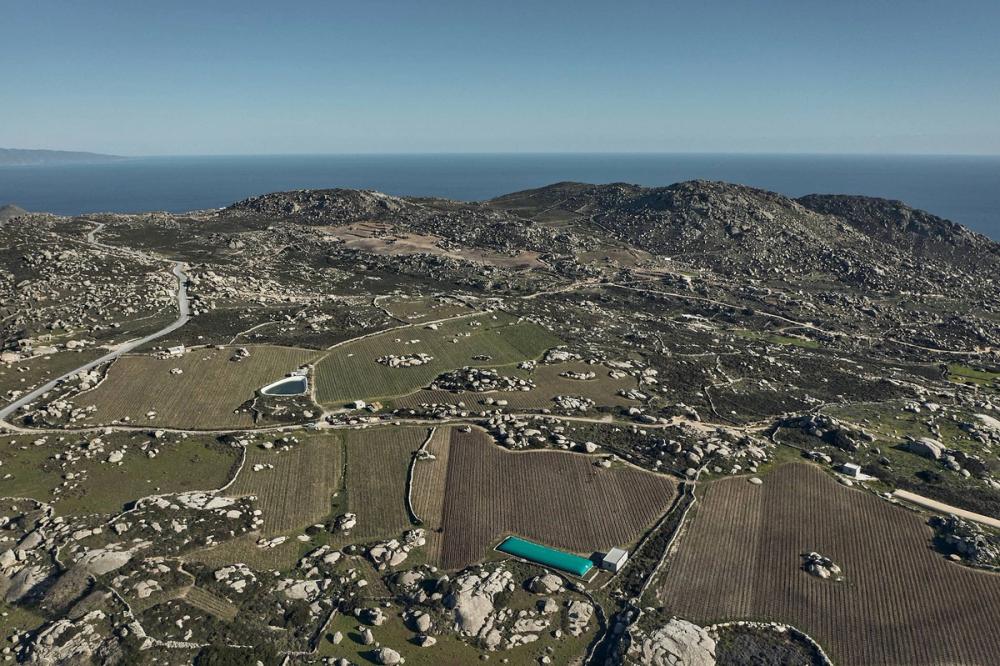
Aerial view of Clos Stegasta - called a Clos because it is walled in by natural rocks
Translated vinously, this harsh climate and the stress it puts the vines under preserves a backbone of acidity in the resulting wines, imbuing them with salinity, freshness, purity, power and a good deal of the magic of this extraordinary site.
Make no mistake, the wines made from Stegasta defy pigeonholes and stereotypes and are quite simply unique fine wines of the world.
A little bit of context

Pilgrim crawling - note the traffic cones to allow crawlers
Although the team at T-Oinos is just starting to put Tinos onto the map for wine lovers, for the Greeks it has long been a spiritual home – the Church of Panagia Evangelistria with its ‘miraculous’ icon of the Virgin Mary is a key destination for Greek Orthodox pilgrims. Every August 15 visitors to the church crawl on their hands and knees 800 metres up the steep hill as a sign of devotion. The road to the church has a ‘crawling lane’.
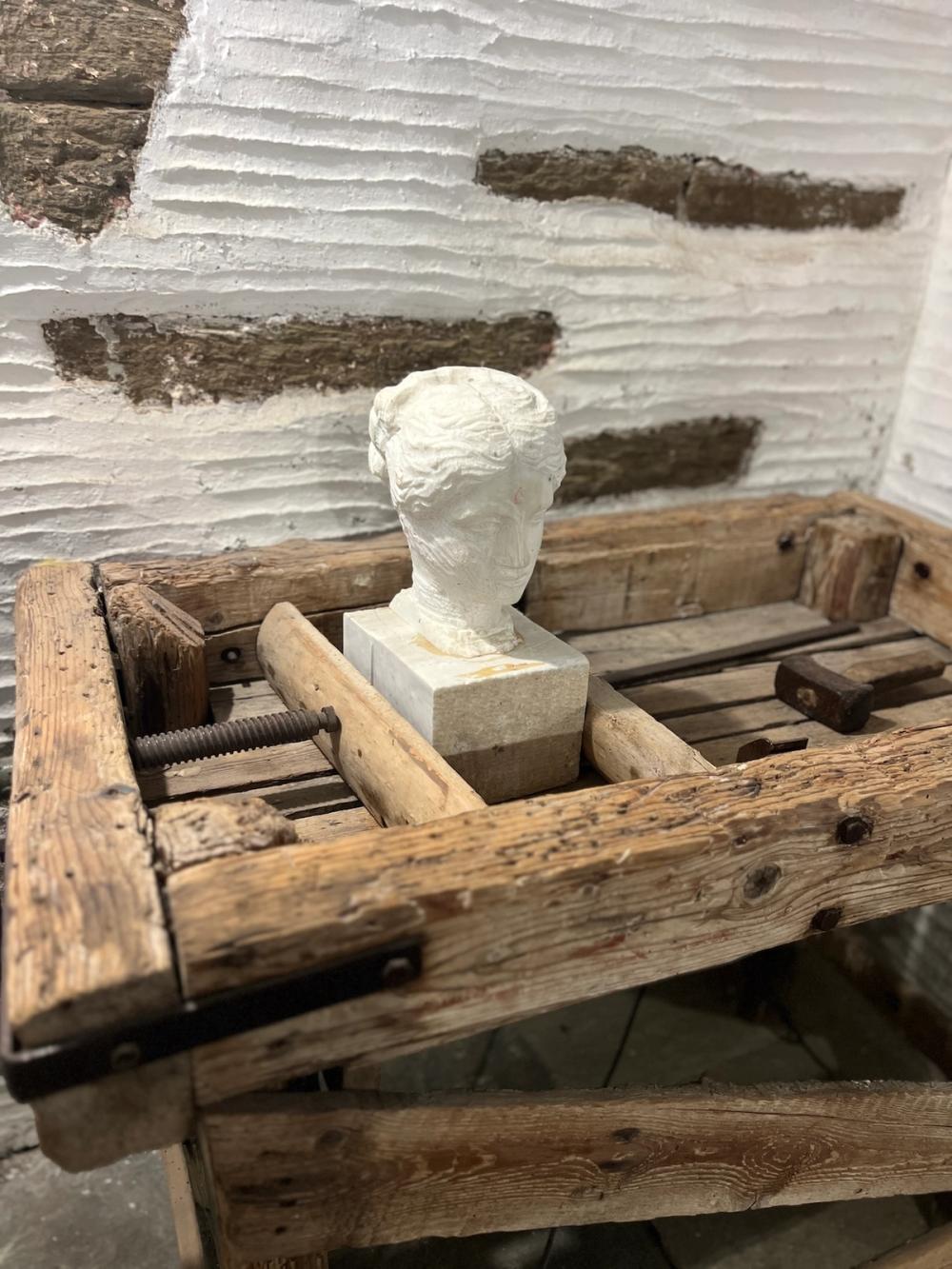
Yannoulis Chalepas' house in the village of Pyrgos - his mother believed it was his sculpture that caused his mental illness
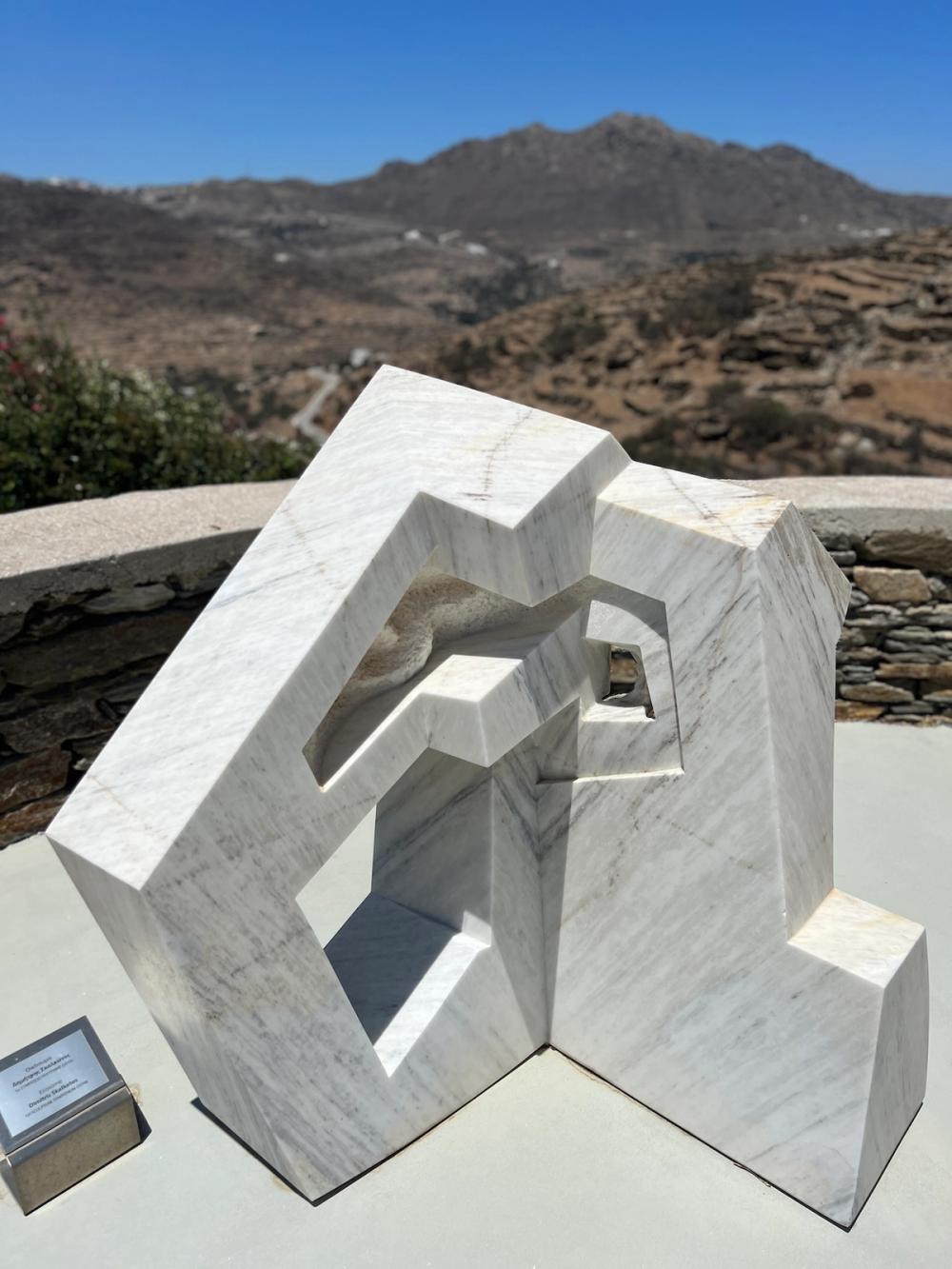
Between a rock and a hard place
Another attraction is the art. The island is famed for its sculptors, Chalepas, Sochos and Valekas, some of whom worked with the local marble still quarried here. When the Venetians colonised Tinos in the 14th Century, they cultivated it, their since abandoned terraces standing barren all around the dry, dusty landscape like the ‘Muertos’ vineyards in the Duoro.
Tinos really is between a rock and a hard place.
What has this got to do with grapes? I hear you ask. The point is that it is incredible that anything can grow in this island’s austere, waterless soil. But it does. And how.
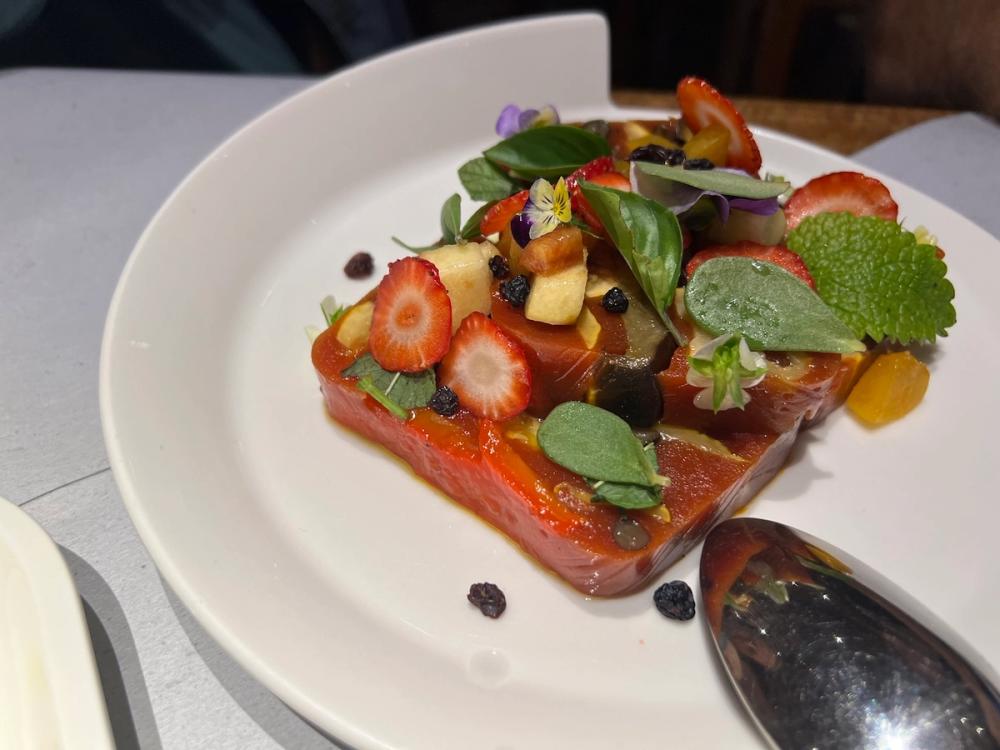
A key part of our trip here is to sample the gastronomy, which is famed throughout the whole of the Aegean; Thalassaki is not only one of the best restaurants to eat in Tinos but it’s one of the best restaurants in the whole of Greece – they grow most of their own produce (and here’s the point) which has the same purity, depth of flavour and complexity that you find in the grapes.
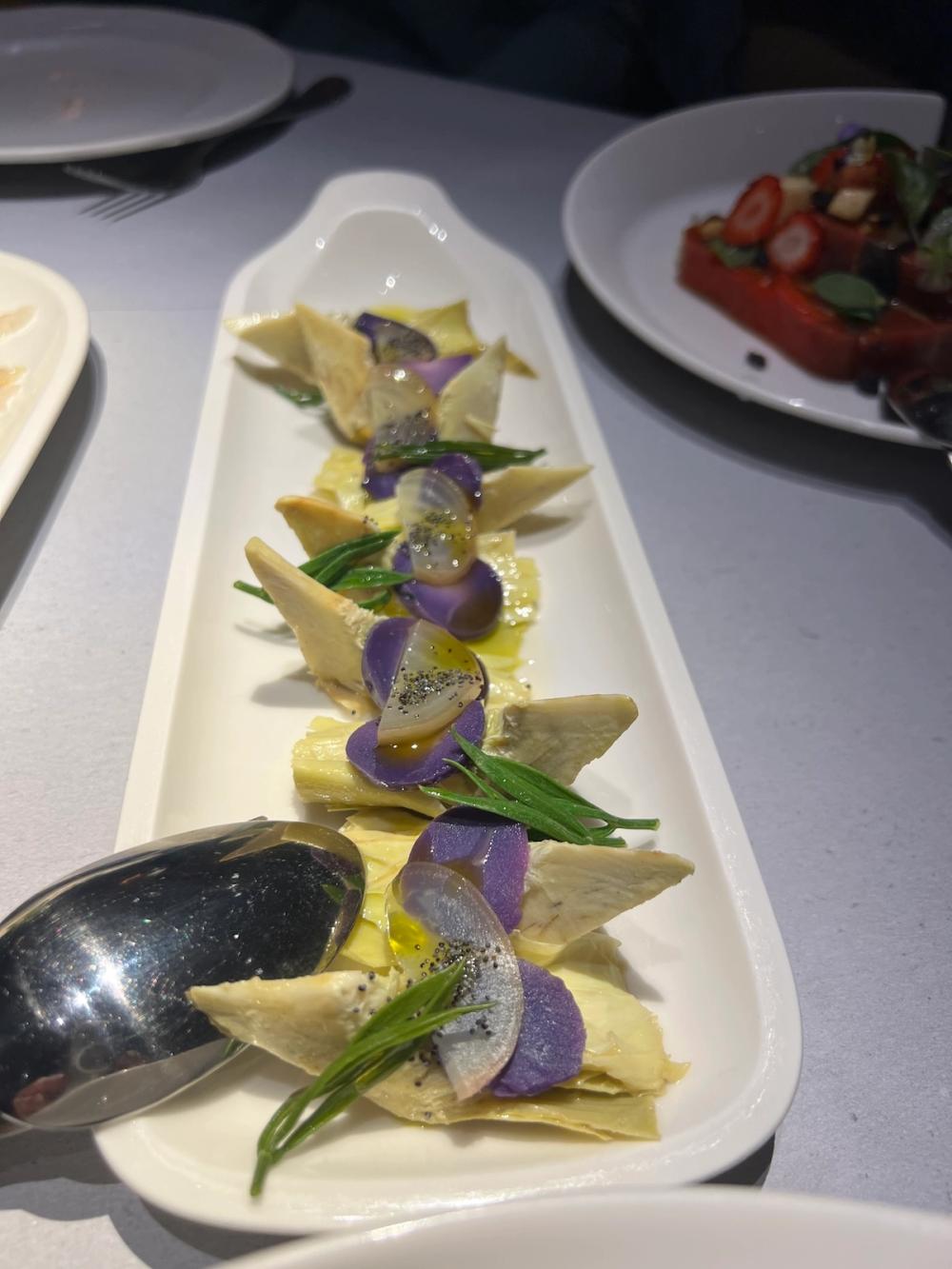
Think you've tasted artichokes? Think again
Whether it’s the local artichokes, fennel, salads, herbs or the many varieties of fig that grow here, the intensity and energy in the food is astonishing – nuances of flavour you also pick up in some of the finished wines.
Once a plant takes root here it’s almost as if it’s rewarding the cultivator’s hard graft with a raw energy, flavour and an uncommon sense of purity.
Making the best wines on earth
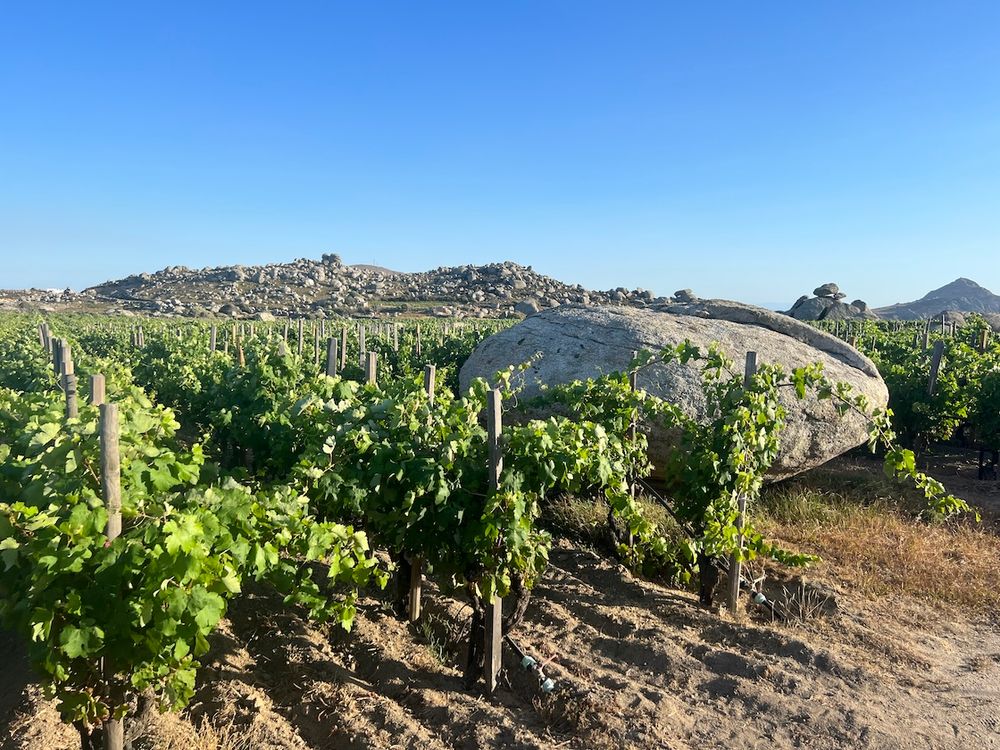
Clos Stegasta
It is no surprise then that when T-Oinos owner Alexandre Avantangelos and good friend Gérard Margeon, (executive head sommelier for Alain Ducasse restaurants) set out 25 years ago to look for a vineyard site that could produce extraordinary premium wines they found it here on the Stegasta Plateau, a site that Margeon sensed could produce wines like ‘liquid pebbles’. He wasn’t worng.
The fact that the team could plant new vines on such a protected environment was because it had always been used to grow grapes – they were simply resurrecting agricultural use which dates back to 4000 BC.
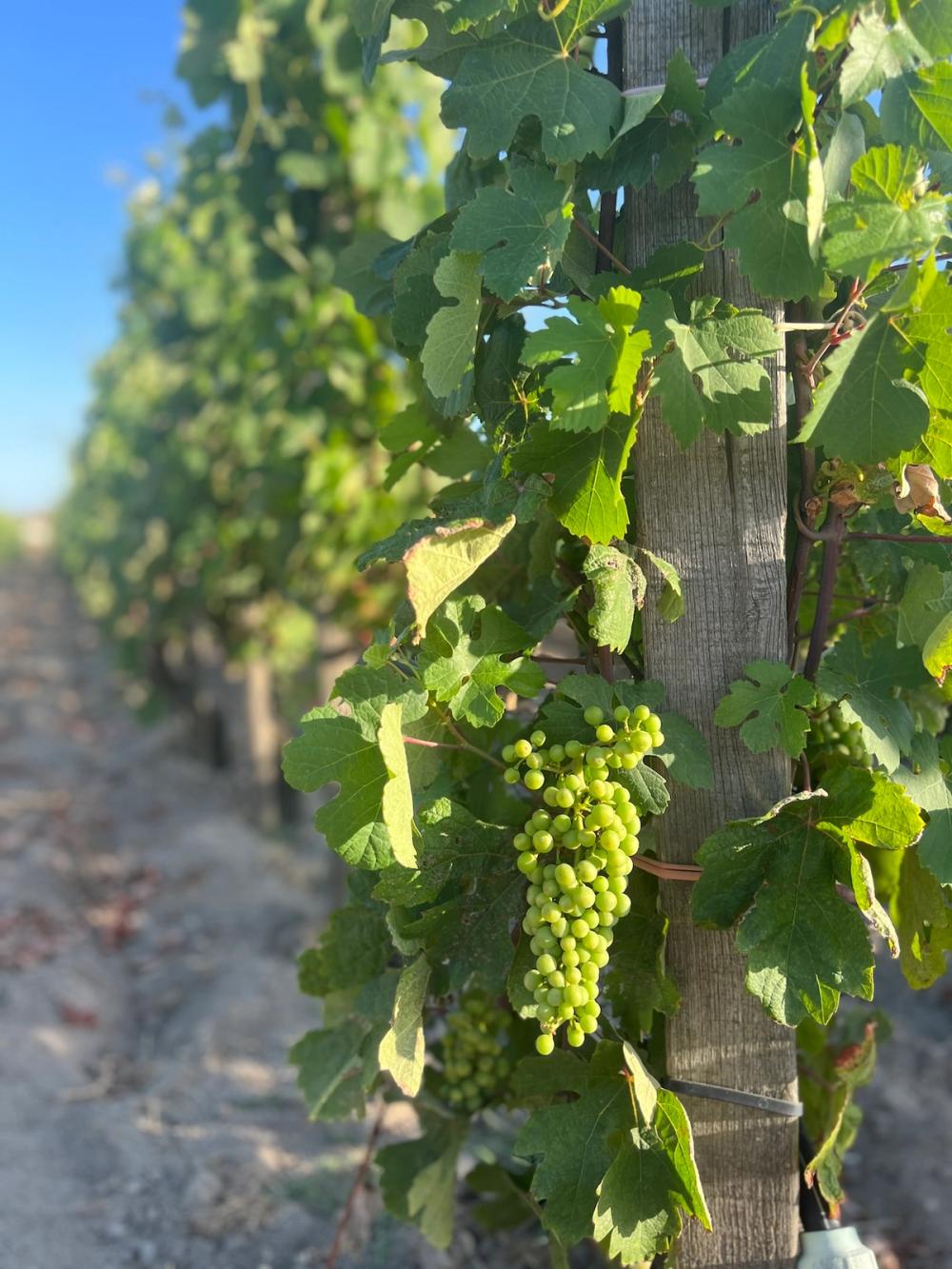
Young bunches of Assyrtiko at Clos Stegasta
It was important also that any investment benefitted the local community – the vineyard team are all local with vineyard manager Michalis Tzanoulinos born and bred in the local village of Falatados. This is no ‘get rich quick’ project but rather one which is an integral part of the landscape – physical and socio-economic – and will stand the test of time.

Construction of the new winery is already under way ©George Vdokakis
In terms of that investment, once the new winery is completed this autumn there will have been a cool €15m put into the project, with plans under way to slowly expand to a total of 120,000 vines planted at the end of next year across the three vineyards bringing acreage from 13 hectares up to 17. There are no plans for massive expansion however, the intention has always been to keep yields low and quality high, hence the limited production.
Once the name T-Oinos was chosen for the estate – T stands for Tinos and Oinos is the Greek word for wine – planting started in 2002, the first vinification was in 2008 and the first bottling a year later.
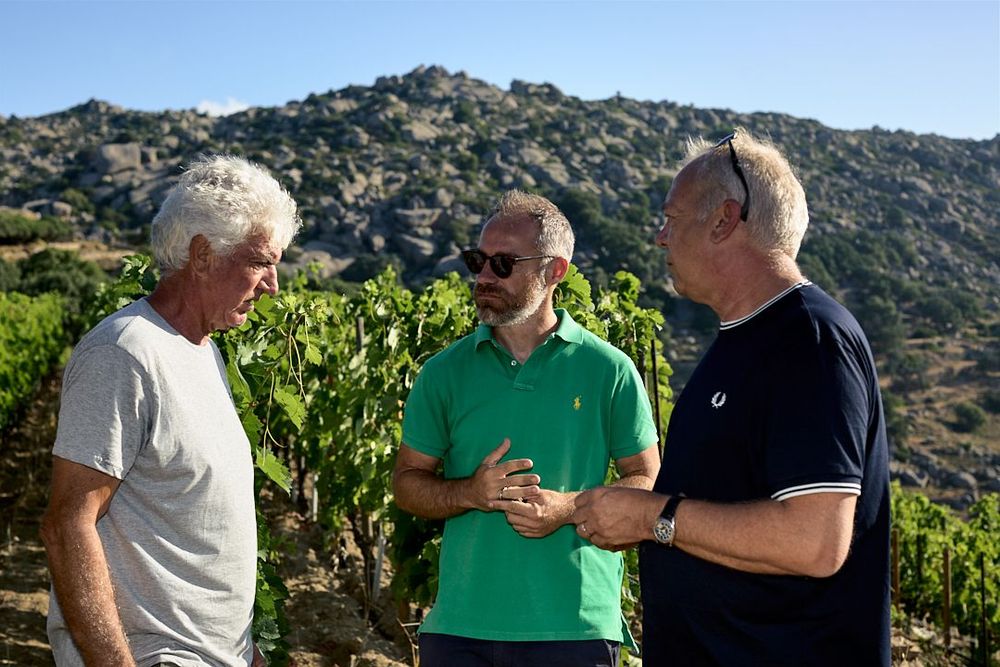
Dream team: Stéphane Derenoncourt, Thanos Georgilas and vineyard manager Michalis Tzanoulinos (r-l) ©George Vdokakis
The next key member of the team to join the ‘exec board’ was master vigneron Stéphane Derenoncourt in 2016 who has implemented strategy in 140 wine estates worldwide. He made his intentions clear from the ouset – declaring he was going to make the greatest white and red wine ever made.
His eschewing of a purely scientific approach to winemaking and the belief in the typicity of vines and their environment chimes well with the vineyards on Tinos – his skill and input as a consultant, according to Thanos Georgilas, being focused on the soil, its aeration, nutrition and specific attention to the vines.
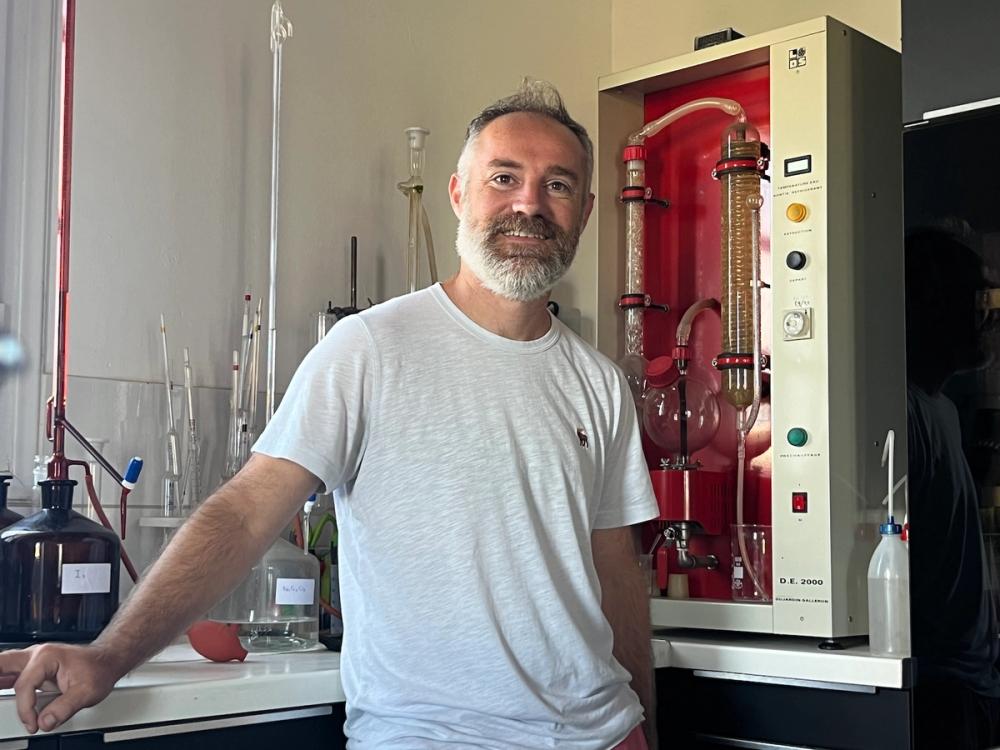
Thanos Georgilas - scientific background
Georgilas, who joined two years after Derenoncourt, is a winemaker with a scientific background whose experience at Opus One and Château Latour was focused on isolating their indigenous yeasts which help to define the typicity of their specific terroirs. He’s doing the same here with all yeasts being indigenous.
In an extensive tasting of back vintages of all six of the estate’s wines it was refreshing to see the diversity of styles play out – no cookie cutter formulas here.
So how were the wines tasting?
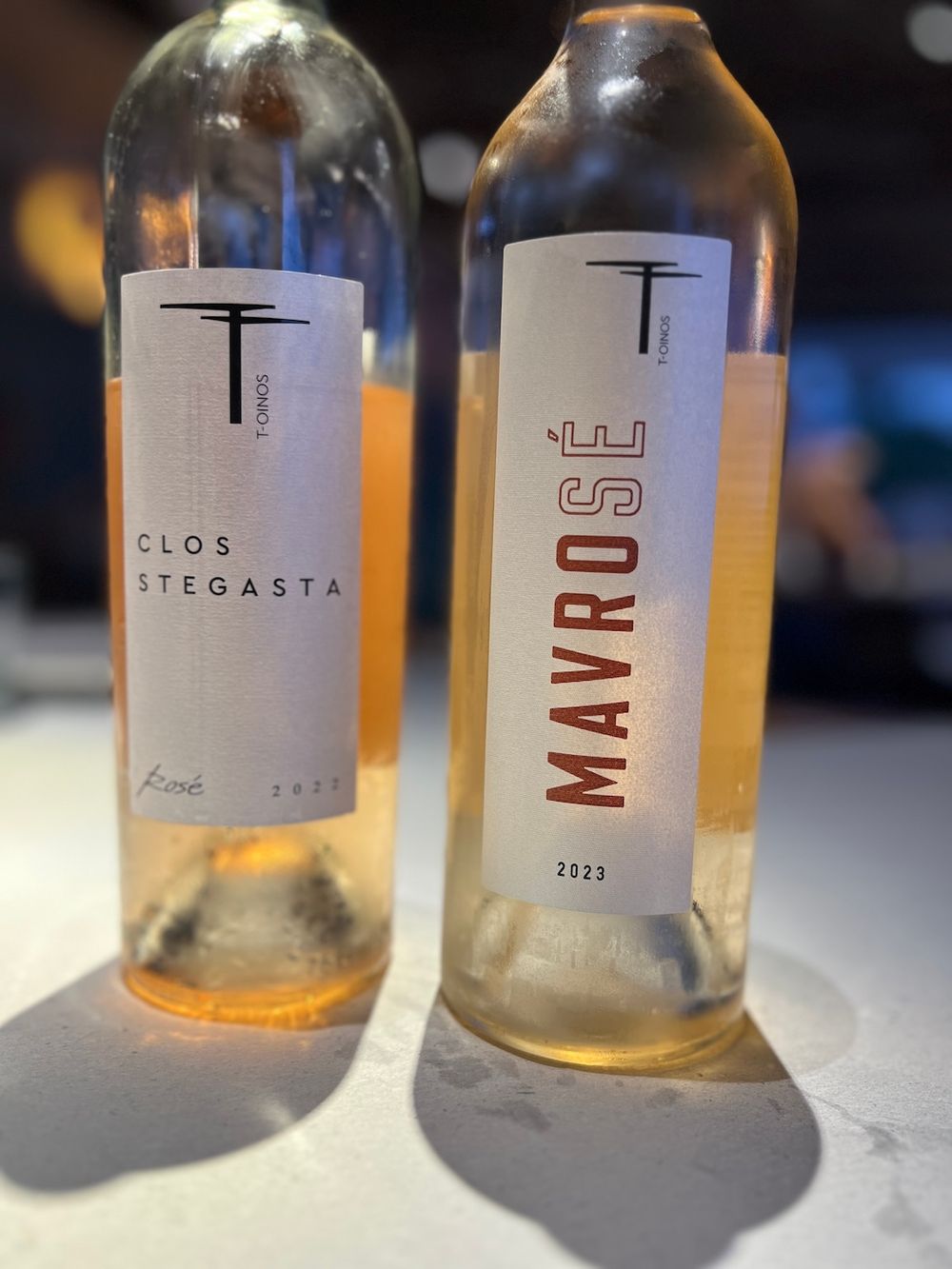
The Clos Stegasta Rosé is new this year
Mavrosé 2023
This refreshing, fruity blend of direct-pressed 80% Avgoustiatis and 20% Mavrotragano is found in a lot of the good eateries on the island – unsurprising as it is a classy rosé and gastronomic.
Very pale pink, with aromas of wild berries (raspberries) and hints of fresh nut. Light to medium bodied on the palate, it is fresh, pure, silky, (less ‘oily’ than the rosé from Clos Stegasta as it only spends a short period of time on its fine lees before bottling). The Avgoustiatis brings a lovely saltiness to the wine and firm acidity; the wine finishes with a lemon pith/ zest, slightly sour grapefruit note. Begs another sip.
Clos Stegasta Rosé 2022
A new wine (released in June) and a terroir-driven rosé that is right up there with the very best. A blend of 35% Assyrtiko 35% Mavrotragano 20% Avgoustiatis and 10% Malagousia, direct pressed and then aged on lees for six months. The Assyrtiko brings the aromatic profile while the Malagousia gives floral notes, saltiness and a charge of mineral.
Brilliant light to medium pink with saffron highlights; on the nose the wine offers so much more on the nose than the Mavrosé – intense and extremely complex, you detect flowering wild herbs, yellow stone fruit, dried orange peel, watermelon, quince and concentrated fruit preserve; In the mouth you feel the extra lees-ageing, there’s a plumpness here, oleaginous, medium weight, beautifully poised with a yin and yang sweet/ sour playfulness. Impressive.
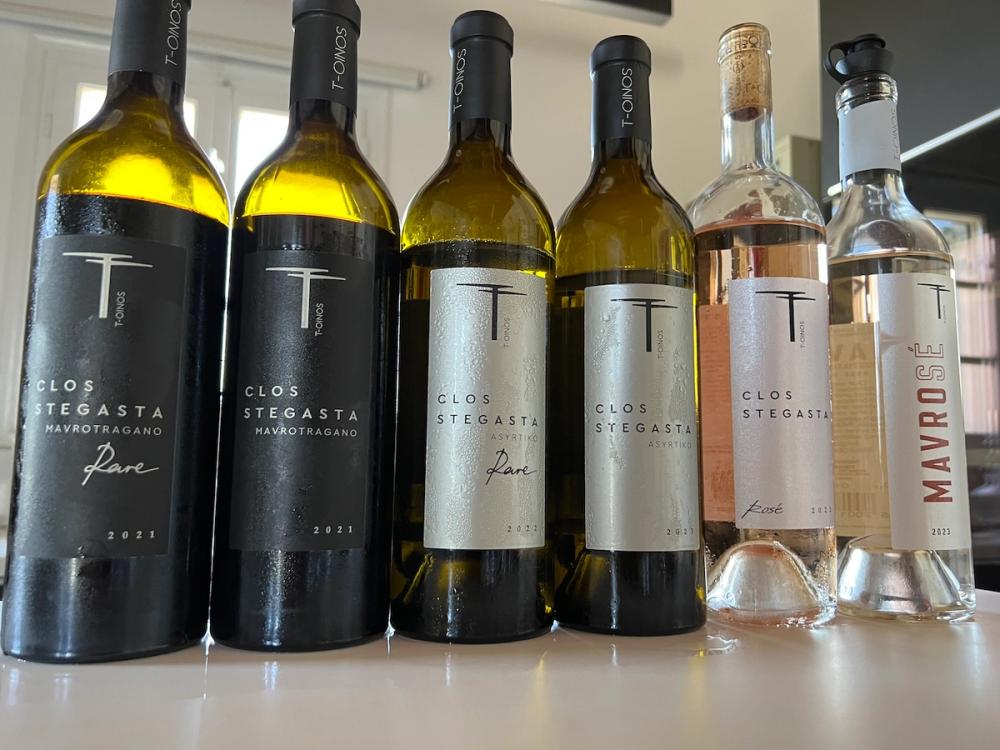
The new vintages of the 6-strong T-Oinos portfolio - benefitting from a more uniform design than when first launched.
Clos Stegasta Asyrtiko 2023
Benchmark Assyrtiko fermented in a mix of formats (steel tanks, amphorae and wooden vats) that really delivers the power of Clos Stegasta. 2023 was a difficult growing season with the latest bud break experienced here and a short vegetative cycle. Continuously hot summer and low rainfall brought extra stress to the vines, making maturity tricky.
Brilliant platinum/ straw to look at; the nose is complex with pretty floral and fresh thyme notes; the mouthfeel is warm, intense, concentrated – a wine of great vivacity, with a mix of citrus fruit and bitter lemon; finishes a point with a saline prickle on the tongue. Bottled at the end of April – the wine remains open for the first three months then closes down for a couple of years before becoming expressive again.
Clos Stegasta Asyrtiko Rare 2022
Highly sought-after 100% Assyrtiko from a special parcel within Clos Stegasta, fermented in a mixture of oak casks and amphorae then aged for 6-7 months over lees, and spending an extra year in bottle. Only released in exceptional vintages (2019 and 2021 did not produce one).
As it ‘says on the tin’ this is a Rare wine in short supply, the 2022 was released in April and by June there was just 400 bottles left. 2023 will only have 1000 produced.
Hugely expressive wine; on the nose the wine is complex, almost mysterious, with sweeter fruit notes than the previous wine, with lime and lemon blossom, sweet oak spice. In the mouth the wine is big and broad, immense, not so much 'Asyrtiko squared' but more 'to power of 3' with the ripeness of the fruit cloaking the mineral-charged, acidic core of the wine. Good tannic grip, blood orange on the finish which lasts for about a whole minute.
Mavrotragano - but not as you know it
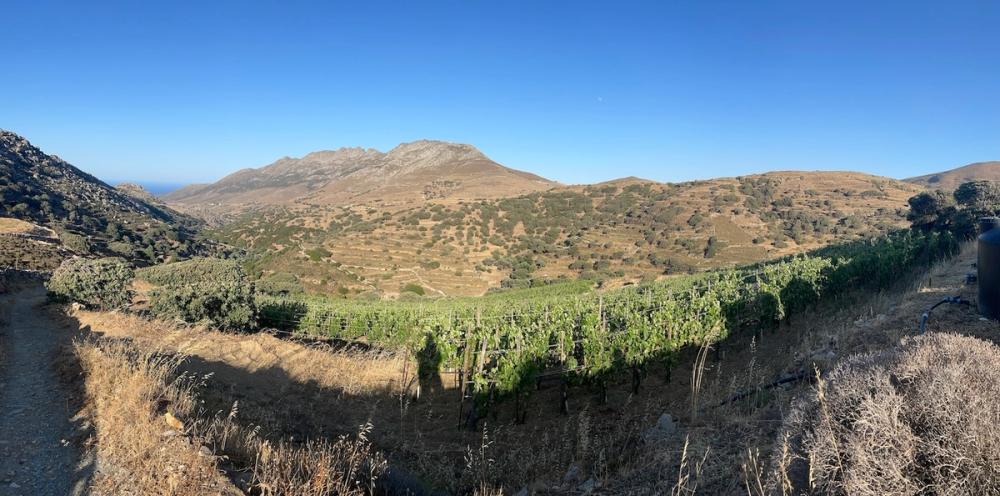
East-facing Rassonas vineyard - Mavrotragano grown here on terraces is used in the Mavrotragano Rare wine
Haridimos Hatzidakis in the 1980s and Paris Sigalas a decade later are largely to thank for resurrecting the fortunes of this special (and expensive) grape variety. The name translates as ‘black-crunchy’ and you can feel this in the mouth – dense, fine-grained tannins – like a wilder Mediterranean cousin of Nebbiolo.
Badly handled it can be funky dusty and very tannic which is why Georgilas says settling on exactly the right moment to pick this grape is vital – and picking slightly earlier helps keep the alcohol in check and maintain the freshness.
T-Oinos vinifies the grapes from two different soil types (sandy/ granitic & clay/ schist) separately and whole berry in big oak casks. Georgilas also performs limited pumpovers so as not to extract bitter tannins.
Clos Stegasta Mavrotragano 2021
Made with Mavrotragano from Clos Stegasta where it takes up 10% of the overall vineyard. The wine matures for a year in 500l barrels.
Superb tannins here – rounded, velvety but structured which get better with age as was evidenced tasting some earlier vintages. Complex nose has a mélange of pure blackberries, plum, earth, violets, black fruit, espresso, thyme and fennel – here’s a wine that gives so much as it opens out in the glass. On the palate the wine is fresh, round, bags of black fruit, a green vegetal note and dark chocolate. Wow. Such finesse too and only 14% abv - remarkable given the temperatures here in summer.
Clos Stegasta Mavrotragano Rare 2021
One of the highlights of the tasting and a wine that is right up there with the world’s best.
Made with Mavrotragano grown on the terraces of the East-facing Rassonas vineyard, after fermentation the wine is matured for 12-14 months in 500l barrels. Mavrotragano is a grape that makes rustic, dense, fruity and generous wines and here the team is going for a much more elegant style with savoury notes.
The nose is intense and complex with wild bramble fruit, dark chocolate and Asian spice tin; in the mouth the wine is fresh, ripe, concentrated with a lovely, rounded mouthfeel with firm but micro-fine tannins, I picked up black fruit, iodine and violets with a saline edge to the dry, ‘river stone’ finish. This is a wine with huge concentration and massive ageing potential that is drinking beautifully at this point.
Mavrotragano is a grape that can present the winemaker with a fair amount of volatility but here the team have harnessed its power and avoided the variety's pitfalls with consummate skill.
The wines of T-Oinos are sold and distributed in the UK through the Oeno Group. T-Oinos is a commercial partner of The Buyer to discover more about them click here
